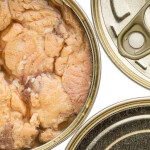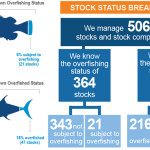One of the biggest challenges to delivering a seafood product that inspires consumer confidence, according to many NGOs, is oversight and monitoring on the water. The Nature Conservancy (TNC) is working with large-scale fishers to achieve just that, aiming to increase on-the-water monitoring in the world’s industrial fleets. TNC is a science-based, non-advocacy global conservation organization that works closely with businesses and governments to scale solutions to the leading global resource challenges.
SeafoodSource interviewed Rob Johnson, the senior corporate engagement advisor for fisheries and aquaculture at TNC, to discuss the organization’s work on transparency in supply chains that can help build trust with the consumer.
SeafoodSource: How does The Nature Conservancy work with large-scale fishers to promote good management and healthy stocks that deliver reliable supply to seafood markets?
Johnson: Large-scale fishing occurs on more than half of the ocean’s surface; that’s over three times the area covered by land-based agriculture. About 3 billion people worldwide rely on seafood as a significant source of protein and, as demand grows, so does the pressure placed on critical ocean ecosystems and marine species.
Nearly 90 percent of today’s large-scale fisheries are already overfished or are currently being overfished. A range of factors, including overfishing and illegal, unreported, and unregulated (IUU) fishing activities threaten to disrupt ocean health and global seafood supplies, leaving fishery-dependent communities under-resourced.
We engage with large industrial fisheries because 2 percent of the global fishing fleet accounts for more than 50 percent of the world’s catch. The vast majority of illegal and unsustainable fishing is undertaken by legally licensed – but unmonitored – fishing vessels through prohibited activities such as mis- or under-reporting of retained catch, shark-finning, and retaining species like turtles and marine mammals.
The challenge is that without vessel visibility on the water, there is low confidence that seafood products are caught legally, sustainably, and without labor abuses. So, we focus on transparency within the first mile of a fishery’s supply chain to advance 100 percent on-the-water monitoring through electronic monitoring (EM) and/or human observers. Electronic monitoring includes the use of video cameras, GPS, and sensors onboard fishing vessels to track fishing activity on the water. EM is a proven, cost-effective tool that illuminates blind spots in fisheries and fills critical data gaps that impede transparency, enforcement, and science-based fisheries management.
SeafoodSource: What is the relationship between monitoring on the water and confidence in the supermarket?
Johnson: Tuna fisheries produce 5 million tons of fish annually, with a dockside value of USD 10 billion (EUR 9.1 billion). However, a lack of transparency is threatening global seafood supply, harming coastal communities and undermining marine conservation efforts.
One of the biggest obstacles to the sustainable management of global tuna fisheries is the lack of on-the-water data. Fisheries authorities and supply chain actors often lack the necessary data to manage fisheries sustainably and ensure that vessels are complying with fishing regulations. On-the-water monitoring provides this data, which ultimately helps level the playing field for law-abiding fishers around the globe.
Many technological advances have enabled fishery managers to better understand what is happening on the water, but without independent monitoring on vessels to verify catch activity, it is difficult to identify when IUU activity is occurring in the first mile of the supply chain. Companies that are unable to verify compliance with environmental and social standards risk losing valuable sources of income, in addition to increasing business risks throughout the supply chain. Total on-the-water monitoring is the industry's future.
Reliable data can help retailers and seafood suppliers combat IUU in their supply chains and ensure compliance with environmental and social standards. Increased data on supply chains can also significantly enhance consumer trust in products found on supermarket shelves.
The Tuna Transparency Pledge is a global initiative led by TNC that is an industry and government pledge aiming to achieve 100 percent on-the-water monitoring via electronic monitoring and/or human observers across all industrial tuna fishing vessels by 2027.
Without this transparency at sea, major seafood buyers face significant risk of stocking illegally and unsustainably sourced tuna products, compromising the longevity of their supply chains, stakeholder trust, and reputation.
SeafoodSource: What is the ask of companies? What are they joining on to with this initiative?
Johnson: The Tuna Transparency Pledge is a bold but achievable global initiative led by TNC, in partnership with the industry, NGOs, and governments. Progress-monitoring tools have been developed to support business signatories in achieving the goals of the pledge.
To implement the Tuna Transparency Pledge, signatories aspire to take three steps to ensure 100 percent on-the-water monitoring throughout their tuna supply chains by 2027:
1. Implement systems to track and verify progress against the Tuna Transparency Pledge. Where applicable, this includes seeking that vessels register for the Vessels in Other Sustainability Initiatives (VOSI) list, hosted by the International Seafood Sustainability Foundation (ISSF), or an equivalent tracking and verification tool;
2. Develop a credible plan to meet the 2027 target; and
3. Pledge to monitor progress through an annual verification process.
SeafoodSource: How is the program being rolled out?
Johnson: We are working with leading retailers, seafood companies, and governments across the globe to join the Tuna Transparency Pledge, aiming to achieve 100 percent on-the-water monitoring across all industrial tuna-fishing vessels within their supply chains or jurisdictions by 2027.
The Tuna Transparency Pledge officially launched this April ahead of the 2024 Seafood Expo Global in Barcelona, Spain, with Walmart, Sam’s Club, Albertsons Companies, Thai Union, and the governments of Belize and the Federated States of Micronesia as the initial signatories. The more companies and governments that join the Tuna Transparency Pledge, the greater momentum is possible for effective tuna fisheries management and sustainability of this crucial resource.
Reliable and accurate information from on-the-water monitoring benefits every step in the supply chain, ensuring tuna supplies for future generations, verifying compliance with fishing regulations, and delivering the standards consumers expect from the industry
The Nature Conservancy has collaborated with the ISSF and Sustainable Fisheries Partnership (SFP) to develop clear, adaptable auditing, tracking, and verification protocols to help signatories advance their goals under the Tuna Transparency Pledge. This technical guidance includes the use of existing databases and tools to track and verify monitoring coverage by tuna fishing and carrier vessels, such as the VOSI list, Seafood Metrics tool, and FishSource Database.
Companies can get involved by joining onto the Tuna Transparency Pledge and aiming to achieve 100 percent on-the-water monitoring on all industrial tuna fishing vessels that they source from by 2027.
Retailers, foodservice companies, restaurants, and other market actors can use their purchasing power to drive innovation and transparency in their supply chains so that customers can confidently buy tuna products that were harvested sustainably and legally. By advocating for the adoption of robust on-the-water monitoring through the Tuna Transparency Pledge, industry leaders can help guarantee a long-term and sustainable seafood supply for the market.








